The Samsung Galaxy S7 and S7 edge Review: Part 2
by Joshua Ho on July 5, 2016 8:00 AM EST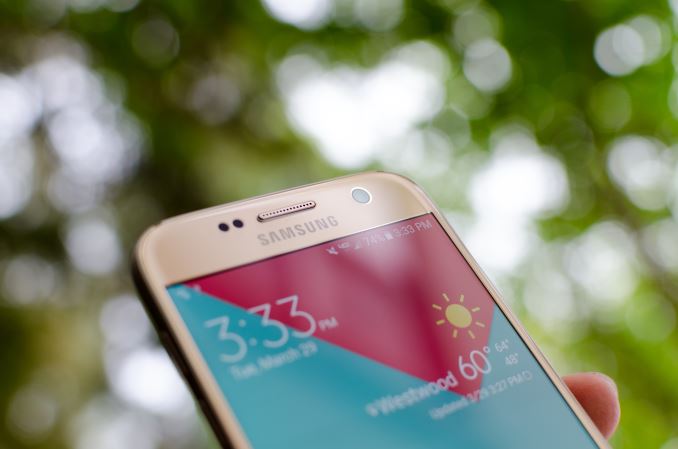
With part one of our Galaxy S7 review, it was clear that the Galaxy S7 was at least a mild improvement to the Galaxy S6 in some ways, but there were still many areas to investigate. At the time, we were in the middle of transitioning to our new 2016 benchmark suite, which meant that it was necessary to re-test the Galaxy S7.
Our 2016 benchmark suite attempts to really push our testing in general to a new level of depth and more importantly, more focused on the overall user experience. When reflecting upon the value of AnandTech from a testing perspective, it’s clear to me that while part of our value is running benchmarks across a wide range of phones, another part of our value is being able to run tests that others wouldn’t be able to run at all.
With our new test suite for 2016, our extended suite of benchmarks attempts to focus on the latter to go deeper in reviews in a meaningful way. I definitely enjoy examining architectural details through microbenchmarks, but for general reviews our standard test workflow needed to be focused on user experience in a deeper way. With this in mind, we can get into the data that we were missing with part 1 of the review. Of course, if you haven’t read part 1 of the Galaxy S7 review, I highly recommend reading it first just to get a better introduction into the basics of the Galaxy S7.
Battery Life
Of course, now that we have our full suite of benchmarks we can start to look over in detail how devices perform. While we’ve gone over some of the results before it’s probably fair to say that our discussion of battery life on the Galaxy S7 was woefully incomplete with part 1 of the review. It’s also worth noting that internally we were still working on our 2016 web browsing test at the time so it wasn’t necessarily complete and sufficiently consistent and accurate. In the time since, we’ve been able to get all of the bugs ironed out and get a test that provides useful data that our previous tests didn’t.
As battery life is a critical part of our testing, it’s important for us to get this right, and in order to get useful relative comparisons we have to make sure that every device is tested in the same manner to avoid bias in one way or another. In order to achieve this, all devices have all possible background services disabled, as well as sync and automatic app updates. In order to try and make an even comparison we also set the display to 200 nits brightness on a 100% average picture level display, also known as a blank white screen. However, one area that we aren’t necessarily able to control for 100% of the time is ambient temperature, device orientation, or material contact. While tests that don’t reach TDP limits won’t see any effects, TDP-limited tests will see a delta here, but it’s hard to estimate just how much of an impact exists here.
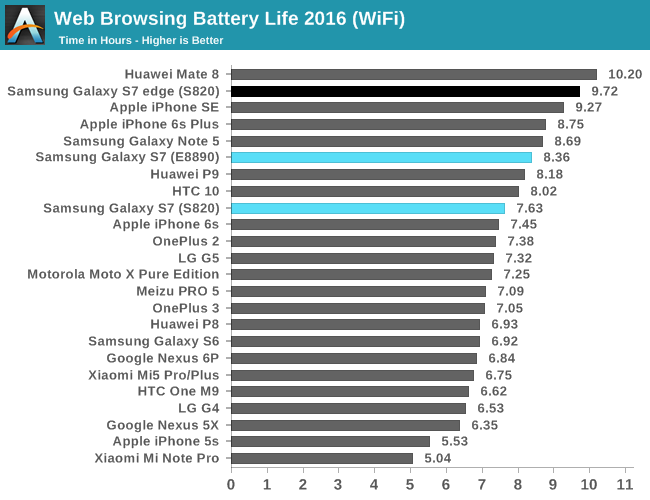
With this baseline in mind we can move on to the actual results. As seen in the chart above for WiFi web browsing on our new test it’s worth mentioning that the data here has changed as changes to the test have affected results, generally bringing battery life down or keeping it around the same. The Galaxy S7 does fairly respectably here, although the Snapdragon 820 version is definitely showing either architectural or implementation inefficiency here when compared to the Exynos 8890. A delta of about 10% means that the Exynos 8890 GS7 uses about 1.38W average here while the Snapdragon 820 GS7 uses about 1.51W in this test assuming that the battery capacity is nominal. If you subtract out an estimated display power the delta that can be attributed to non-display factors is something like 30% here. Interestingly, the HTC 10 is mildly more efficient here with its higher density LCD, with the AMOLED display consuming something like 10% more power despite the presence of dark-themed webpages to try and bring some balance here. The Galaxy S7 edge is pretty much the top here, but achieves its battery life through sheer battery size rather than efficiency.
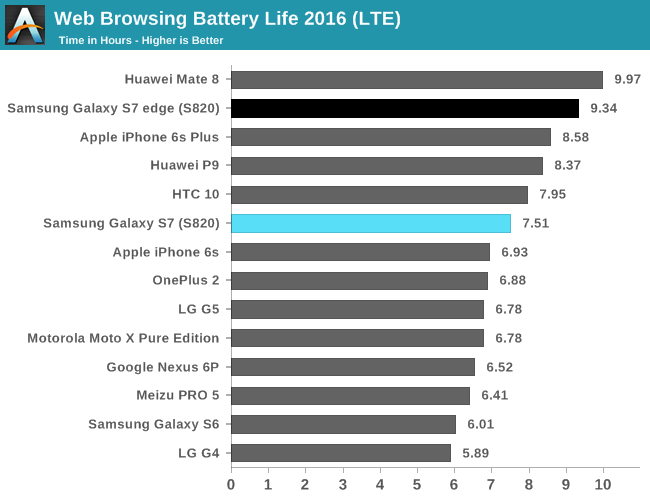
Moving on to LTE we can really start to see the battery life advantage that the Snapdragon 820 brings. It turns out that as a communications company, Qualcomm is good at making radios. One of the most obvious ways that this shows is in power, as the Snapdragon 820 basically has the same battery life whether you’re on LTE or WiFi, which isn’t necessarily the case with other devices. Unfortunately, we haven’t been able to test the Galaxy S7 with Exynos 8890 in comparable conditions for LTE so we can’t really see how power of the S820 modem compares with the Exynos’ Shannon modem, but we continue to see that the Galaxy S7 S820 is a bit behind the HTC 10 in battery life due to the use of an AMOLED display in high-APL workloads. However, the difference is nowhere near what it was in the past, and is close enough to not really make a huge difference. The Galaxy S7 edge performs well here, but on the basis of its battery size rather than efficiency.
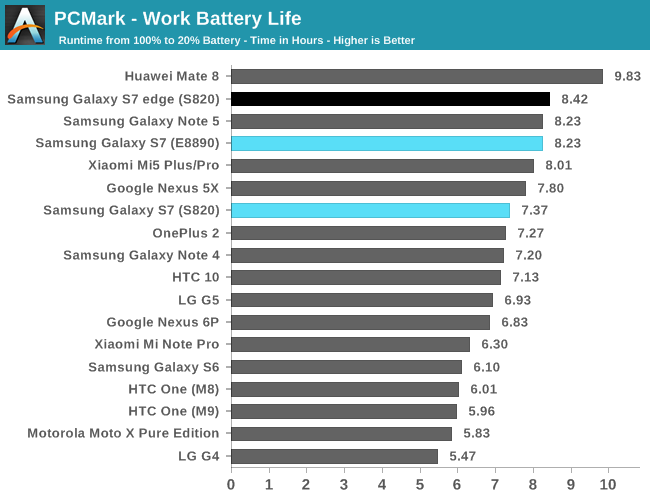
In the interest of not just relying on our own web browsing tests to try and get a handle for what battery life is like in general purpose compute situations, we continue to use PCMark’s battery life test to see how performance is in a benchmark that doesn’t attempt to equalize the amount of work done per unit time. Here the Galaxy S7 actually seems to be a fair bit better than the HTC 10, but this is likely due to the previously mentioned binning differences and some differences in governor as the delta in power and performance isn’t really all that much. The Galaxy S7 edge extends the lead here, again mostly due to the larger battery as the two devices are generally quite similar to each other.
Moving on to throttling performance we’ve transitioned to GFXBench’s Manhattan test on infinite rundown instead of T-Rex for this year as some devices from certain vendors have a tendency of reaching vsync on T-Rex which meant that it was difficult to see just how much throttling occurred over the duration of the test. After some testing it’s evident that for the most part throttling behavior is not necessarily changed by Manhattan either, so there’s not much need to retain T-Rex for high-TDP tests. Basemark OS II’s battery life testing is also rather questionable at this point, so we will no longer be reporting these scores as the methodology isn’t up to par with our expectations for 2016 and beyond.
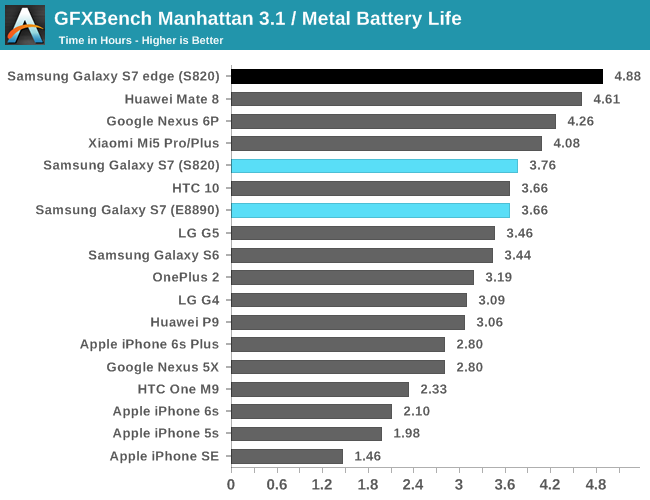

In the case of Manhattan, we continue to see some of the sinusoidal behavior seen in T-Rex throttling as it seems that Samsung’s throttling algorithms tend towards a more underdamped behavior than critically damped like HTC’s. However, for whatever reason it looks like the Galaxy S7 edge ends up with similar oscillating throttling behavior. Interestingly enough, even though the Galaxy S7 spends more time at higher performance states than the HTC 10, it manages to last longer, which is likely due to the lower APL of this content in conjunction with forced power save modes, and higher sustainable skin temperatures due to the glass back with heatpipe cooling to help distribute heat. Of course, the Galaxy S7 edge manages to last longer than either due to its larger size and battery.
Overall, the Galaxy S7 has decent battery life, while the S7 edge has great battery life due to its relatively large battery compared to its display size. The improvements here aren’t necessarily going to blow you away unless you get the Exynos 8890 variant, but it’s good to see that we’re finally back to improving on battery life with the launch of the Snapdragon 820 compared to the Snapdragon 810 and 808’s rather disappointing power efficiency due to the use of a high-power implementation and process node. I’m not sure the Snapdragon 820 is really the best design we’ve seen on 14LPP when it's more on par with 14LPE SoCs for efficiency, but it’s good enough that it doesn’t fundamentally compromise a device.


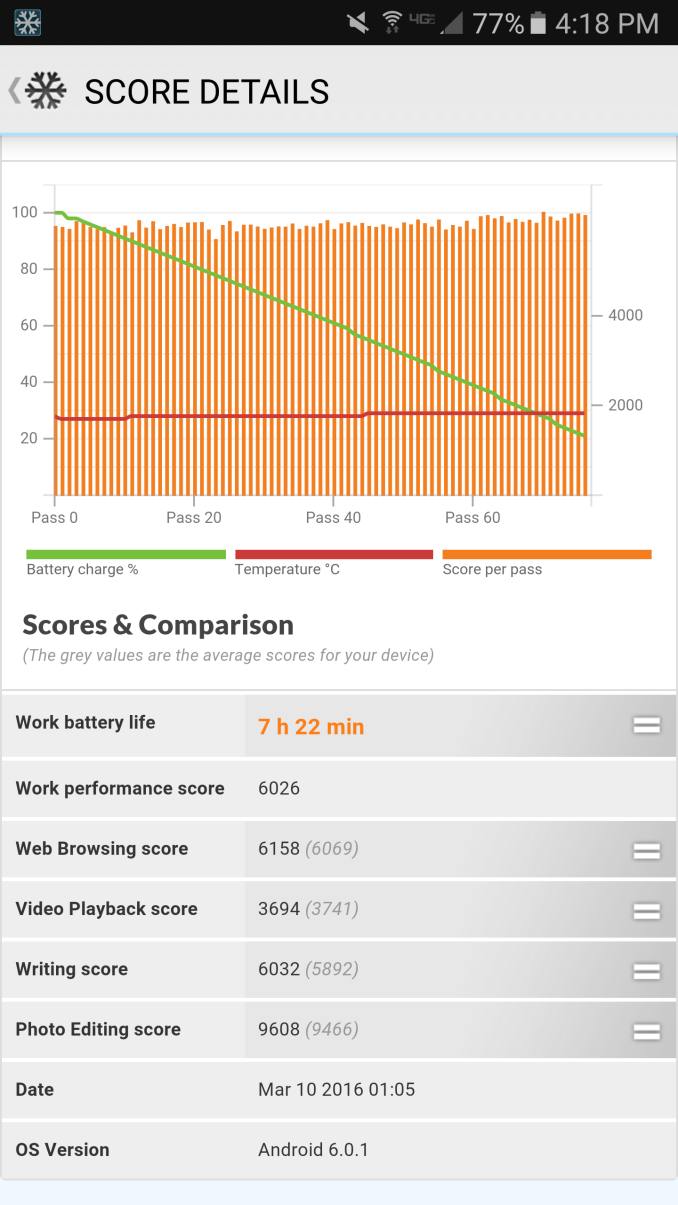
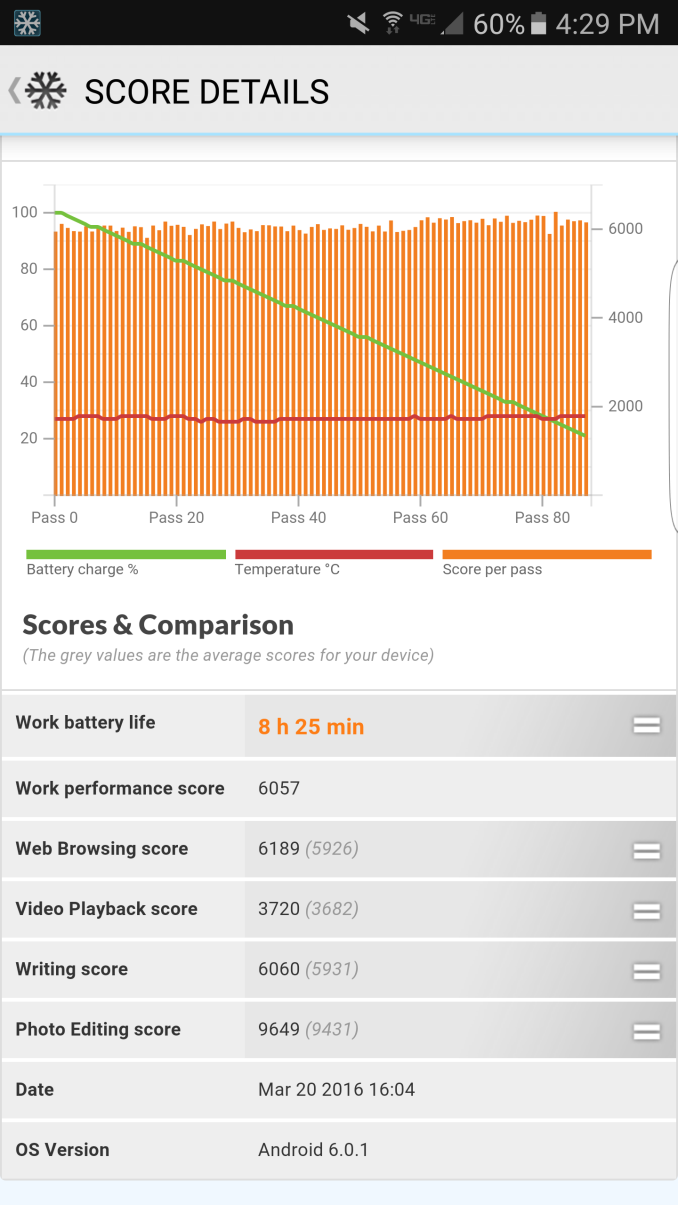
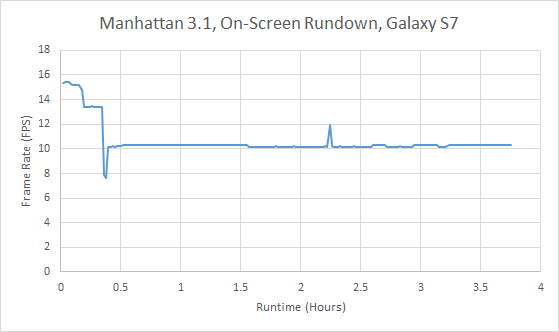
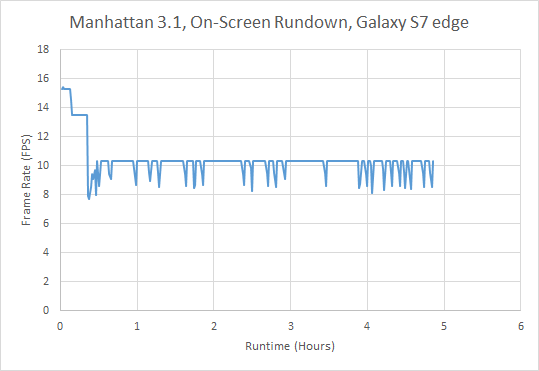








266 Comments
View All Comments
Ryan Smith - Tuesday, July 5, 2016 - link
"Some battery tests missing Exynos values or Edge values."This is a pretty common misconception, but AnandTech isn't located in a single, central office, which impacts how we do testing. Most tests are done in isolation anyhow, so it's not an issue, but LTE is by its very nature a location-sensitive test. In this case the International (Exynos) S7 is with our international editor, Andrei, which means that it wasn't able to be tested alongside the North American (Snapdragon) S7.
more-or-less - Tuesday, July 5, 2016 - link
Doesn't make up for the fact that even after 4 months, this review looks rushed and incomplete. One of the most underwhelming reviews I have read in this site, and it's obvious that the quality of articles have gone down massively.I now only trust Andrei to give proper articles, others seem to be reading from a old script.
Chris_m1296 - Wednesday, July 6, 2016 - link
how did the exynos version manage 2800 on the slingshot es 3.1 unlimited test? mine only manages 2200 and even futuremark lists the exynos version at 2200.Newair - Tuesday, July 5, 2016 - link
The S7 edge is without a doubt the worst phone I have ever owned.1st of all, it's texture is very slippery
In fact if I hadn't dropped it within 5 minutes of buying it and doing some damage, I would have returned them by now. Yes them. Bought 2.
Constantly charging battery
Perhaps it's just the way I hold the phone, but constantly touching something on the screen with a finger and off it goes in a different direction
Keyboard is miserable. More often than not, when I press 0 I get 9. Have never had this much trouble typing.
In all, if I could afford it, I would through thing out the window.
dawheat - Tuesday, July 5, 2016 - link
This might be one of the worst reviews I've read on Anandtech and the slide though gradual, is persistent.The S7 Edge is the more exciting device and one of the few genuinely unique Android devices but the review generally ignores it outside of a few token areas.
For example, how many times does the writer have to state that battery life is good only due to size? Who really cares how it accomplishes class leading battery life, considering that it's still much more compact AND lighter than the 6S Plus. Yet the S7 Edge gets incredibly faint praise for battery life - only one of the most important aspects of a device.
And with the comment about it being a heavy phone, I'm befuddled how a 10% heavier phone in the 6S Plus gets a free pass.
The camera review also ends up showcasing nerds in basements where only perfectly still photos matter- in the real world for example, trying to get pictures of your moving kids is hugely dependent on focus speed and the difference between a mushy blur and actually capturing a memory.
Oh and of course, not actually running browser benchmarks on the stock browser that comes with the device...again.
But all together just bleh - compared to someone like Andrei, this writer is just balls.
more-or-less - Tuesday, July 5, 2016 - link
"But all together just bleh - compared to someone like Andrei, this writer is just balls."-- Agree on this entirely. Compared to deep-dive articles that Andre produces, this review is just worthless. How someone could approve this review after 4 months of 'investigation' is beyond my understanding? Better get another reviewers, this Joshua guy doesn't insipre any level of confidence.
How did he manage to get a post in Anandtech to review phones is still a mystery.
They took 4 months to publish this, SMH :(
retrospooty - Tuesday, July 5, 2016 - link
Yup. Totally agreed.msh - Tuesday, July 5, 2016 - link
HiThis snapdragon browser you write you need to install to get acceptable performance on the SD820 variant, where is one able to obtain that?
I cant find it in google play.
variab1e - Tuesday, July 5, 2016 - link
While I greatly value these reviews. They lack what every review I've found lacks , a test of the radio's RF performance. First and foremost these are phones, or in the broadest sense, wireless communications devices; what could be more important than its ability to send and receive data?! I really respect Anandtech for its technical accuracy, and think that adding this component to its reviews would help to differentiate it from other vanilla sites. A lab setup to a standard candle signal source and then real world tests would be nice, but even the latter alone would be useful!anactoraaron - Tuesday, July 5, 2016 - link
hmmm..."The Galaxy S7 and S7 edge are still great phones, but the difference between a $400 phone and a $700 phone are these details when phones like the OnePlus 3 are providing almost the same product at a dramatically reduced price. There are clear points of differentiation between the Galaxy S7 and OnePlus 3 or Mi5 in terms of features, but I don’t think it’s enough to be worth the $300"
Unless you like looking at a 1080 pentile amoled and think that Samsung Pay, a wildly better display, VR capability (not mentioned in this review - although just about everyone who got this device got a VR headset for free) and water resistance isn't worth $300. After owning the G4 and the ridiculously terrible panel on it for a year I was REALLY happy paying just north of $100 more than I did for the G4 at launch time for the S7 Edge.
Seriously I feel betrayed that we all had to wait this long for this review and even given all this time, it feels rushed and as if the reviewer didn't really want to do it, especially the tone at the end. It's like he's saying, "yeah it's the best phone for android - if that matters at all - but it still feels 'meh' to me just like everything else these days. You are better off with the iPhone."
What exactly has apple done to innovate and drive this industry forward the past 2 years? Force touch? Squeeze identical components into a smaller device?
Seriously I don't know how a review like this would be published on Anandtech. It's reviews like this for what has been clearly the best android phone of the year is how this site gets constantly called out for bias. And this time for good reason.